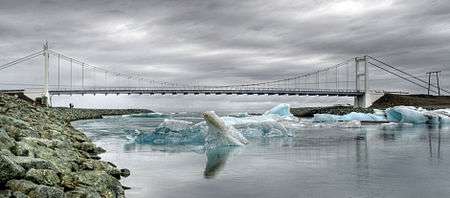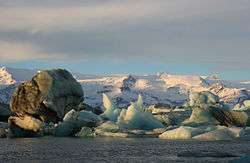Jökulsárlón
Understand


Jökulsárlón literally means glacier lagoon (Jökull - glacier, lón - lagoon). At the time when first settlers arrived in Iceland, the edge of Breiðamerkurjökull, an outlet glacier of the great glacier Vatnajökull, is thought to have been 20km further north than it is now. The climate began to cool in about the year 1200, the cold spell reaching a peak in the period 1600-1900, which is sometimes known as the "Little Ice Age". As a result the glacier advanced until about 1890, reaching a point only about 1km from the coast at Jökulsá river. The eastern part of the glacier eroded the sediments of Breiðamerkursandur to a depth of up to 300m below sea level, the sediment being carried forward by the river Jökulsá. Without the river the glacier could not have eroded such a deep basin, because it is the river that carries the sediment to the sea.
The warm period from 1920 to 1965 caused great changes in Breiðamerkurjökull glacier. It retreated very quickly, leaving a lagoon up to 190m deep where the glacier snout had been, and several kilometers of glacial moraines were exposed on both sides of the lagoon. The lagoon grew from 8km² in 1975 to 15km² in 1998. Large blocks of ice break off the edge of the glacier, which is about 30m high, keeping the lagoon stocked with icebergs.
The lagoon, when frozen, was used in the 2002 James Bond film, Die Another Day, for a BMW chase scene.
Landscape
The white cap of Breiðamerkurjökull glacier dominates the lagoon and its icebergs. Jökulsárlón is separated from the sea by only a short distance, and the combined action of the glacier, the river that empties from the lake, and the ocean may eventually transform it into an inlet of the sea. There are plans to prevent this from happening, since the only road in the area passes over the narrow isthmus.
Climate
The weather is fairly temperate year round around Jökulsárlón but one should bring a waterproof winter coat and wear waterproof shoes. During the winter it may be cold, windy, and rainy so winter weather clothing is advisable. During summer, a lightly insulated jacket may make an extended time viewing the lagoon more enjoyable.
Fauna

Seals can frequently be observed swimming in the lagoon or resting on the shores or icebergs. Shoals, herring and capelan are brought into the lagoon by tidal currents and become pray to the birds. In the summertime skuas, big seagulls, nest on around the lake. In the protective mode they occasionally don't hesitate to attack people.
Get in
Jökulsárlón is on the edge of the National Highway 1 so very accessible if you stop on the side of the road. The small office that offers boat trips is on the east side of the arch bridge that crosses the discharge from the lagoon.
Fees and permits
As with all natural attractions in Iceland, there is no entrance fee.
Getting around Iceland is rather easy, since there are few roads. Because Jokulsarlon lies along the major ring road it is easily accessed. The two best ways are (1) rent a car from Reykjavik or (2) rely on the highly efficient, very punctual public bus that will happily drop you off for as long as you like. Because car rentals in Iceland tend to be very expensive (well in excess of US$150 per day for a compact Suzuki SUV) their public national transit system is outstanding. Buses can be taken virtually anywhere; take one to Jokulsarlon, stay for a few hours, then catch another headed in either direction along the ring road.
See

- Jokulsarlon Lagoon - The lagoon is easily accessible from the large parking area on the east side of the lagoon. A small hill by the office offers a nice view of the lagoon. Another viewpoint with a smaller parking area is on the west side of the lagoon. This viewpoint is slightly elevated above the lagoon.
- Ice On The Beach - In addition to viewing the lagoon, consider visiting the beach to see ice that has washed up on the shore. On either side, east and west, of the bridge over the discharge from the lagoon there are tracks to parking areas a few hundred meters from the road. During the winter, the beach on the east side of the bridge provides the best vantage point for sunrise. The beach on the west side of the bridge is oriented southwest and aligns nicely for sunset.
Do
- Apart from the obvious, marveling the amazing site, there are also boat trips available on amphibious vehicles. There is a small office next to the lagoon that runs trips into the lagoon and amongst the icebergs from June 15 to September 15.
- "Jeep" trips drive up onto portions of the ice cap.
Eat
The small office next to the lagoon offers coffee, hot chocolate, soup, hotdogs, and cakes.
Sleep
There is no accommodation at the lagoon itself but there are several hostels and other accommodations in the surrounding area. There is also accommodation at Höfn, 60km east.
Stay safe
Go next
Jökulsárlón is accessible by car and is located on the Ring Road (Route 1) between Höfn and Skaftafell National Park in Southeastern Iceland. The lagoon is about 50km from Skaftafell (but can take an hour) or 60km from Höfn.
After visiting Jökulsárlón, one can travel to Skaftafell National Park and hike the glaciers.